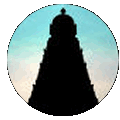 |
 |
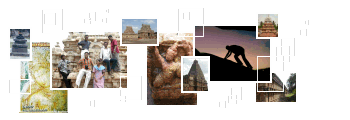 |
http://www.varalaaru.com A Monthly Web Magazine for South Asian History [187 Issues] [1839 Articles] |
 |
 |
 |
http://www.varalaaru.com A Monthly Web Magazine for South Asian History [187 Issues] [1839 Articles] |
|
Issue No. 99
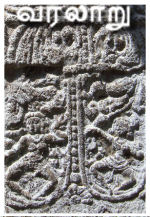
இதழ் 99 [ செப்டம்பர் 2013 ] 
இந்த இதழில்.. In this Issue.. 
|
Series:
Chola Ramayana
After relieving the curse of Ahalya, Sage Viswamitra leads the princes to King Janaka’s palace at Mithila. In Kamba Ramayana, Rama manages to catch a glimpse of Seetha on his way and they fall for each other. This event is not portrayed in any of the early Chola Ramayana narratives - including Kumbakonam and Pullamangai.
Upon reaching the royal household, Sage Sadananda, the son of Ahalya by Sage Gautama, who also happens to be the royal priest (Raja Guru) of the kingdom, receives them and reports to King Janaka. Janaka enquires upon the sage and the princes and shares his anxiety in finding a suitable bridegroom for Seetha, his only daughter. The cause of his concern is the celestial bow of Shiva, kept in his custody. Seetha was able to move this mighty bow at a young age with her divine powers; so her would be husband should be strong enough to at least lift the bow once and shoot an arrow. Unfortunately none of the princes who showed up in the past were able to move the bow – leave alone lifting it. Viswamitra consoles the King and suggests that Rama, the son of Dasaratha of Ayodhya might stand up to the challenge. Upon his instructions, Rama lifts the bow, tries to shoot an arrow and in the process of doing so, breaks it. The entire court and household of Janaka is overjoyed to see this development and soon a royal union ensues. At Kumbakonam, the panel (No.12) located next to Ahalya episode is worn out beyond recognition. Only few characters are vaguely visible and it is not possible to identify the event portrayed. The following panel (No.13) proceeds further down the storyline of Ramayana and depicts Rama leaving Ayodhya to take up the exile in the forest. This suggests that the events associated with Rama’s marriage are implied but not explicitly sculpted at Kumbakonam. On the other hand, the meeting between Viswamitra and Janaka and the subsequent events that follow are captured in great detail at Pullamangai. Since this is the first significant deviation observed in storyline between the two narratives, it will be worthwhile to discuss them in some detail. A cursory analysis of the Ramayana storyline represented in various early Chola temples suggests that they differ significantly from one another in terms of how they embody the main storyline, what events, themes and characters they project, when and where such projections occur etc. Considering that all of these narratives were sculpted more or less around the same time frame [first half of 10th Century AD], one is left to wonder at the ingenuity of Chola artisans and the cultural setting that stimulated such distinctive elucidations. Henceforth, this series will closely follow the Pullamangai panels for some time until Rama takes up his exile. Pullamangai Panel No.16 – The court of King Janaka King Janaka is seated in a royal chair, in a posture that can be placed between Utkutiasana and Sukhasana. Lack of definite posture suggests his unrest. He is wearing a Makuta and adorned with Necklaces. His left elbow is resting on his knee. His hands are raised in Padaka, indicating an active and engaging conversation with Sage Viswamitra, seated by his side. The substantial raise in hands combined with indefinite body posture suggests an anxious temperament. Obviously, the topic of conversation is finding a suitable alliance for his only daughter. .jpg) Meeting with Janaka Two Chauri bearers are seen on either sides of the king, at a distance. Janaka’s concerns are readily addressed by Sage Viswamitra, seated at ease in Utkudiasana, in a chair equal to that of the King. His left hand is held in Padaka, in a gesture that indicates support and solace. His right hand, firmly held in his thigh, signifies confidence and composure. The Sage is comforting the King and suggesting that Rama, the valiant son of King Dasaratha – might stand up to the celestial challenge. Rama and Lakshmana are seated to the left of Viswamitra, in a slightly lower level chair. This chair is distinctive and is supported by several legs – three of which are visible. Small bedding is laid over the surface of the chair. The youths are seated with legs folded - as a mark of respect to the elders. Their bent heads suggest humility and modesty. Portions of their body are worn out. A male figure is seated to the right of King Janaka on the floor, at a distance. His headdress is distinctive. He is also participating in the conversation (as suggested by his raised right hand). It is difficult to identify this figure with Sage Sadananda, who was held in high esteem by the King and the rest. The relevance of this unidentifiable character in this panel is not understood at present. Composition Overall there are seven characters in this panel. The dominant characters are Janaka and Viswamitra; the pivotal point being the conversation between the two. By dedicating one complete half of the panel to Janaka, the sculptor underscores his significance. Only one other Chola Ramayana panel [at Tiruchennampoondi] highlights Janaka in such importance. Janaka’s anxious mood is compensated by the casual and relieving gesture of Viswamitra who reassures that Rama might answer the problem at hand. By seating him at a level equal to that of the King, the sculptor indicates the high reverence in which sages were held in ancient times. It may be remembered that Viswamitra was seated in equal terms with Dasaratha as well, in an earlier occasion. By sculpting Rama in significant proportions to that of the King and the Sage, the sculptors emphasize the importance of the character. Pullamangai Panel No.17 – Rama breaks the bow This is one of the striking events in the story of Rama. Having been challenged with the task of lifting Shiva’s bow, Rama effortlessly takes the bow in one hand, tries to shoot an arrow and breaks it in the process of attempting to doing so. .jpg) Rama breaks the bow Kambar provides a picturesque version of this incident in a famous phrase: “Even those spectators who did not close their eyelids for the fear of losing the victorious moment, managed to catch only a glimpse of Rama lifting the bow; they did not see Rama keeping his feet at the end of the bow; they did not see him tying the bowstring; all that they heard {the very next moment} was the thunderous sound of a breaking bow”. தடுத்து இமையாமல் இருந்தவர் தாளில் மடுத்த தும் நாண் நுதி வைத்ததும் நோக்கார் கடுப்பினில் யாரும் அறிந்திலர் கையால் எடுத்தது கண்டனர் இற்றது கேட்டார் We had discussed the admiration for Sangrama Raghava concept at Pullamangai earlier in the series. We also saw the repetition of this theme in several panels – in a variety of moods, settings and posture. Panel No.17 is an enthusiastic expression of this concept in all pomp and glory. Rama, trying to stretch himself to shoot a powerful astra from the celestial bow – fully dominates the panel. Though his Aleeda posture is the fourth in this series [the earlier ones being Nos.8, 10 and 12] by far this is the most powerful and distinguishing portrayal. It almost seems that the artisans were preparing themselves all the while to eventually sculpt a masterpiece that would stand out the test of time. Rama’s left arm is firmly holding the bow while the right is used to extend the bowstring. His posture is assertive and self-assured. Lacking suitable target in earthly realms, he is aiming at the sky trying to shoot at heavens. A sannaveera adorns his chest, reflecting his warrior mood and composure. Multiple spectators are seen on either side of Rama. Their right hands are raised in Padaka – in adoration of the victorious deed. Janaka and Viswamitra are shown behind the spectators. Both are in conversation, hailing the might and valor of the hero. Lakshmana, sculpted to the right of Rama, is also showing a Padaka. However, having witnessed the strength of his elder brother in earlier occasions, he is not awestruck like the spectators. Composition Like No.16, this panel also has seven characters. Rama in Aleeda posture is the most dominant figure here. By dedicating more than one half of the panel to Rama, the artisans attempt to highlight his energy and vigor in full force. The front view depiction provides an opportunity to emphasize the extreme stretch in his physique, elevating the Veera Rasa in portrayal. Janaka and Viswamitra are second in importance, followed by Lakshmana. The seated spectators elevate the scene with their adoration. this is txt file� |

சிறப்பிதழ்கள் Special Issues 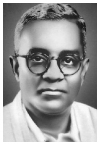

புகைப்படத் தொகுப்பு Photo Gallery 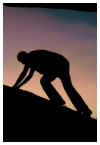
|
| (C) 2004, varalaaru.com. All articles are copyrighted to respective authors. Unauthorized reproduction of any article, image or audio/video contents published here, without the prior approval of the authors or varalaaru.com are strictly prohibited. | ||